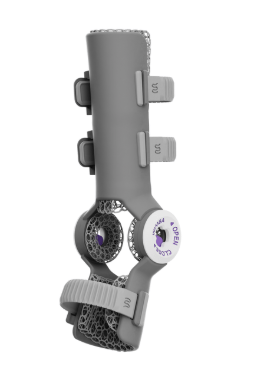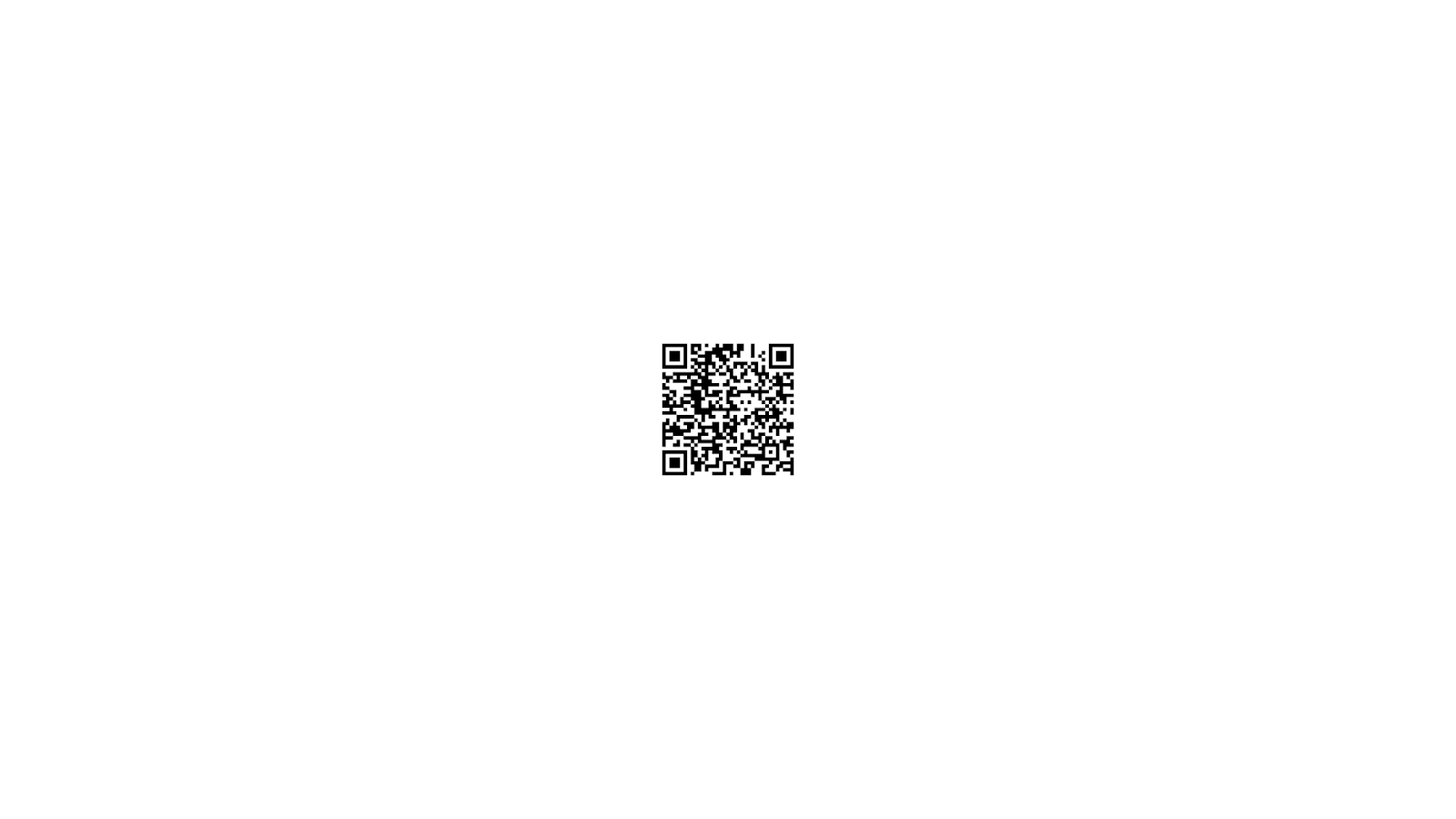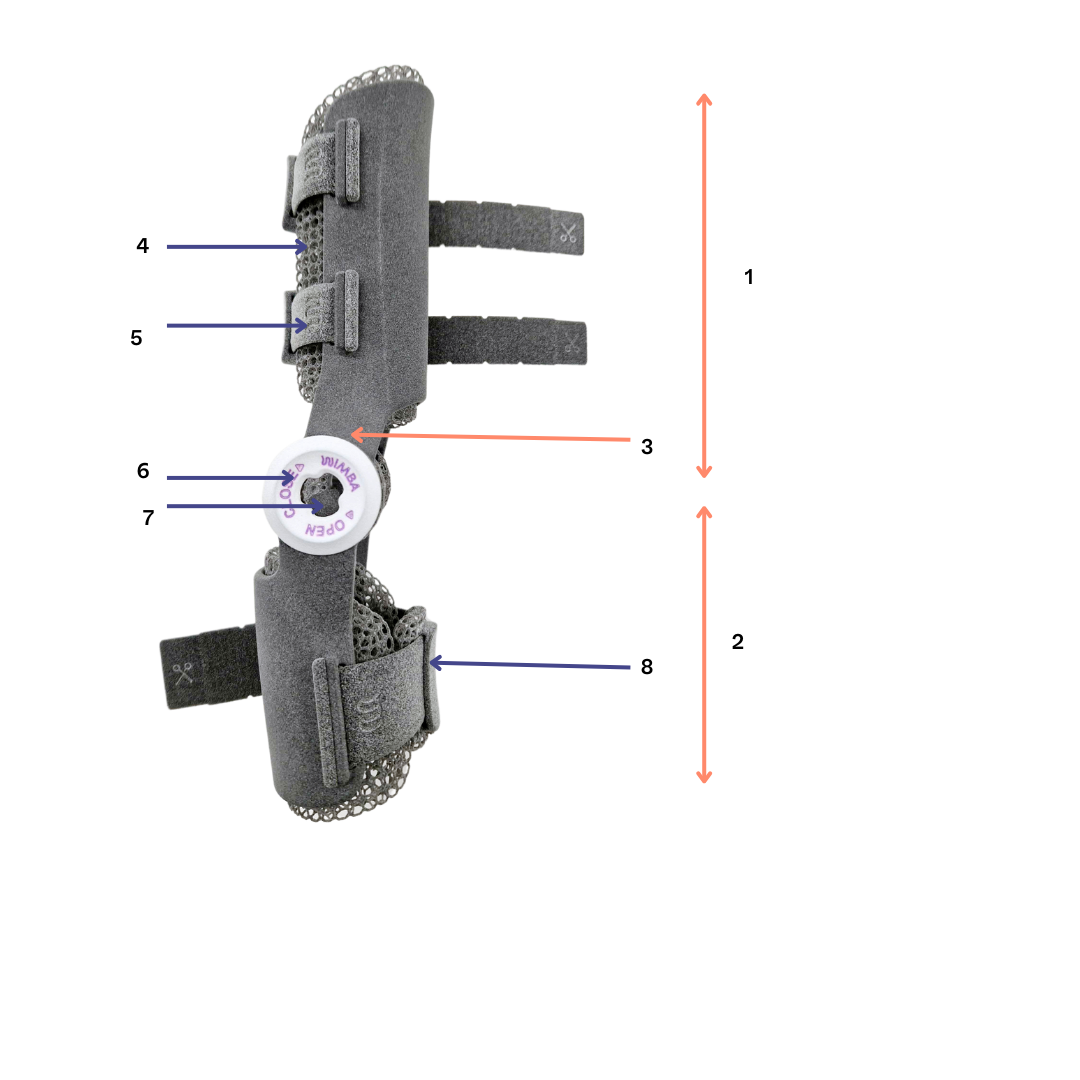WIMBA Carpus Orthosis Pro - User Manual
Protective care of the carpal joint in sagittal and median plane.

READ BEFORE USE:
- Read the entire product manual before use.
- WIMBA products are medical devices available only from authorized partners.
- The orthosis is one of the elements of an individual treatment plan - follow the recommendations of the veterinarian or physiotherapist ordering the use of the orthosis in terms of time, frequency and method of use.
- The orthosis is not intended for 24/7 use.
- Never leave your pet unattended with the orthosis in place.
- We do not recommend using the orthosis on affected skin.
- Prolonged exposure to very low and high temperatures, washing in a washing machine, drying with a dryer, modifying or interfering in any way with the structural integrity of the orthosis is prohibited.
- The dog is a living animal. The process of getting used to wearing medical supplies may be different for each dog. We recommend using positive methods such as desensitization, counter-conditioning and medical training using positive reinforcement.
- If you have any doubts about the use of the product or if the device is damaged, please contact your seller.
- The full terms of the warranty are described in the warranty card included with the product.
Table of Contents
Table of Contents
Video manual 2
Description of the Orthosis Components 3
Modular Parts 4
Hinges with Tokens 4
Opening of hinges: 4
Closing of hinges: 5
Exchanging tokens: 6
Inserts 7
Fastening system 7
Exchanging the fasteners 7
Straps 8
Exchanging the straps 8
Recommended Use and Application 9
Orthosis Fittings 10
Do’s and Don'ts of Your WIMBA Orthosis: 12
Usage: 12
Cleaning and maintaining the orthosis: 12
Storage: 13
Video manual
Description of the Orthosis Components
Every WIMBA Carpus Orthosis Pro consists of (1) an proximal shell (2) distal shell, (3) hinges and
removable components: (4) inserts, (5) straps, (6) caps, (7) tokens, (8) straps inserts and fasteners.
Please note that hinges in other devices manufactured by our company may vary in size compared to the hinge used in your dog's orthosis. The dimensions of the hinge dictate the size of the corresponding tokens, WIMBA Key (Token Tool), and cap.
|
shells |
straps |
fasteners |
inserts |
Tokens |
caps |
|
|
|
|
|
Hinges in WIMBA Carpus Orthosis Pro are fully detachable.
Opening of hinges:
1. Use the WIMBA Tokens Tool (1) - put it on the cap (2).
2. Twist it counter-clockwise.
3. Pull the cap (2) out of the hinge (3b).
4. Pull on the hinge parts (3a, 3b) gently away from each other.
.
Closing of hinges:
1. Push two parts of the hinge together (3a, 3b).
2. Put the cap (2) on.
3. Put the WIMBA Tokens Tool (1) on the cap (2).
4. Using the WIMBA Tokens Tool (1) twist the cap (2) clockwise until it clicks.
5. Pull out the WIMBA Tokens Tool (1).
Exchanging tokens:
- To exchange tokens the hinges need to be open.
- Pull out the token (4) from the hinge (3a).
- Take the desired token and insert it with the sticking part* into the hole in the hinge (3a).
- Close the hinges.
Look for dot markings on the tokens indicating on which side they should be used: one dot - left token, two dots - right token.
When inserting the token, make sure that the side with the dots is facing inward (towards the orthosis).
Inserts
The whole product is complemented by sponge-like spacer cushions - TPU inserts. This feature ensures the orthosis adopts to anatomy and remains securely in place while providing optimal support.
Fastening system
Each fastener consists of: (1) closing buckle and (2) fastener base, attached to the shell with two screws (3). Replacement screws and an Allen wrench (4) are included.
Exchanging the fasteners
To replace the fastener:
- Unfasten the orthosis into separate shells.
- Unscrew both screws using the Allen key provided in the package.
- Remove the fastener base from the shell.
- Insert the new fastener base, making sure the closing buckle fastens toward the shell.
- Tighten the screws.
Straps
The WIMBA Carpus Orthosis Pro is equipped with straps, allowing for optimal positioning and seamless adjustment for the best fit. With their regulation and secure fastening they ensure closure and stability of the orthosis.
|
NOTE: The straps can be cut to the appropriate length by the user, if necessary. When shortening them, be careful not to cut off too much, as this may make it difficult to put the brace on later. |
Exchanging the straps
- Unfasten the clasps.
Begin by unfastening all clasps that hold the strap in place. Remove the insert from the strap. - Remove the old strap.
You can proceed in one of two ways:
Option 1: Slide the entire strap out through the loop.
Option 2: If the strap is too tight or difficult to remove, cut it first and then pull it through.
- Install the new strap: Make sure to insert the strap with the teeth (grooves) facing outward (i.e., the outer side). Pull the strap all the way through until it clicks securely into place. Put the insert on the strap.
Recommended Use and Application
- WIMBA orthosis is a medical device and should be used solely at the discretion of a veterinarian or physiotherapist.
- While using the orthosis, the dog must be under constant surveillance of the owner.
- We recommend using a bandage (vet wrap) or a thin breathable material under the orthosis to prevent rubbing, especially during the initial wear period.
- During the first week of use, the orthosis should be worn for up to fifteen minutes while controlled leash walking, a maximum of three times a day. Subsequently, increase the wearing time every two days by fifteen minutes. The time frame may vary depending on the case and the dog's behavior. Please, see below the Recommended Wear Schedule.
|
DAY |
TIME |
FREQUENCY |
|
1 |
15 Minutes |
Up to 3 times a day |
|
2 |
15 Minutes |
Up to 3 times a day |
|
3 |
30 Minutes |
Up to 3 times a day |
|
4 |
30 Minutes |
Up to 3 times a day |
|
5 |
45 Minutes |
Up to 3 times a day |
The WIMBA orthosis should never be used for 24 hours a day!
|
NOTE: The veterinarian or physiotherapist should guide the animal throughout the entire course of treatment period. It is recommended that wearing schedules ONLY be modified by the veterinarian or therapist to meet therapeutic goals. |
Orthosis Donning
Prepare the orthosis
Check if the orthosis is clean, not damaged and has all of the components correctly applied.
Unfasten straps, so the open orthosis will be ready to be applied on the limb.
Depending on the preferences of the dog and the owner, optionally: unfasten all the shell or shells (by undoing the hinges) to comfortably apply the orthosis to the dog's limb.
Step 1 - Prepare the Paw
Ensure the paw is clean and dry before applying the orthosis. If you're unsure about your dog's skin durability and whether the brace might cause irritation or interfere with dew claw, we recommend using vet wrap underneath it.
|
CAUTION: Vet wrap applied too tight or incorrectly can cause swelling or other damage so follow WIMBA Providers instructions carefully. |
Step 2 - Positioning the Orthosis
Open clips and unfasten the straps so that you can put the limb inside the orthosis.
Place the brace over the dog’s limb, ensuring correct orientation.
Step 3 - Fastening the Orthosis
Insert the straps into the clip hole and close the clips.
Fasten on a standing (or sitting) dog with the orthotic limb on the ground. It is common to need to adjust the brace proximally once standing, if donned in a seated position.
If your WIMBA Token allows range of motion, lift the paw and flex the carpal joint (wrist) to ensure proper possibility of movement.
Step 4 - Correct Fit
A properly fitted and used orthosis contains the following elements:
- The brace is in the correct position on the animal’s limb, not too high, too low, not rotated internally or externally, and WIMBA Tokens are in the joint area.
- It stays in the correct place during the animal's gait, without twisting.
- The brace is not overly tight and does not acutely provoke pressure sores on the dog’s limb.
- No hard elements of the brace (Hinges, Brace frame) contact the animal's limb during any phase of the gait.
NOTE: It is important to monitor your animal at all times to ensure these principles are followed while wearing the orthosis.
|
Please remember! Abrasion may occur as orthosis is an external device applied on the tissues that needs time to acclimatisation. If swelling or skin damage appears, remove the orthosis immediately and contact your WIMBA provider. |
Do’s and Don'ts of Your WIMBA Orthosis:
Usage:
- To ensure optimal functionality of the product, it is recommended to use it within a temperature range of 0°C to 40°C (32°F to 104°F). Prolonged exposure to temperatures outside this range may affect the product's performance.
- Do not heat or modify the orthosis in any way that could alter the structural integrity of the orthosis.
- Do not use the orthosis on abrasions or other skin injuries without consulting with your WIMBA provider.
- Do not allow your pet to bite the orthosis. It is necessary to monitor the dog while using the orthosis and not to leave the dog alone with the orthosis.
Cleaning and maintaining the orthosis:
- Clean the orthosis after contact with salt water, chlorine, sand, soil, mud, grass, leaves, snow etc. after daily activities.
- Hand-clean the orthosis with lukewarm water and mild soap.
- For larger stains, use a sponge or soft cloths to clean.
- Do not wash orthosis in a washing machine or use a hair dryer to dry orthosis.
- Allow the orthosis to air dry. When drying remove any excess water from orthosis to avoid the growth of bacteria and fungi.
Storage:
- Store the orthosis, when not in use, symmetrically fastened (the same number of hooks on the right and left sides).
- Do not place anything on the orthosis that may cause strain or compression to any part of the device or additional components, when stored.
- Do not leave the orthosis in direct sunlight or in any location where it will be exposed to unpredictable weather conditions.
- Do not store orthosis or spare parts in a location animals or children can obtain.
